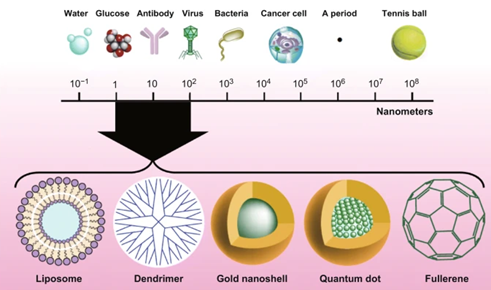Nanotechnology has become well-known as its applications extend across a wide range of science and technology fields. Sometimes, many of us use nanomaterials on a regular basis without even recognising them. The food industry is one of the most common fields in which nanotechnology is used. Nanotechnology has been used to increase the efficiency of manufacturing, packaging, shelf life, and nutritional bioavailability. Several of the most essential basic elements in food such as proteins, carbohydrates, and lipids undergo structural changes at the nanoscale and micrometre scales. Various forms of functional nanostructures can be utilised as building blocks to construct unique structures and add new functions to meals. Liposomes, dendrimer, gold nanoshell, quantum dot, and fullerene are among them (refer to Figure 1).

Figure 1: Various forms of nanostructures in the food industry.
(Source: Nanotechnologies in Food Science: Applications, Recent Trends, and Future Perspectives (2020)).
Inorganic and organic nanoparticles are the primary types of engineered nanomaterials (ENMs) that are likely to be found in the food industry. Sekhon BS. (2010) article states that transition metals (like silver and iron), alkaline earth metals (like calcium and magnesium), and nonmetals (like selenium and silicates) are all inorganic compounds that can be used as food additives, packaging, or storage. Fresh food products with coatings, such as vegetables and fruits, stay active during transit and storage processes. As transmission and storage duration increases, active respiration processes may lead to food spoilage and poor textural and nutrition. Therefore, foods must be preserved to maintain their quality for a longer length of time. Titanium dioxide and amorphous nano silica have the potential to be employed in food packaging as UV protection. According to Maness et al. (1999) and Robertson et al. (2005) studies, food-related pathogenic bacteria have been inactivated using photocatalysis, which increases the peroxidation of phospholipids located in microbial cell membranes. Similarly, nanosilver is used in the food industry as an antibacterial, anti-odourant, and food supplement while nano selenium is being promoted as a green tea additive for health care through selenium absorption.
Next are organic nanoparticles (ONP) or called nanocapsules which are natural chemicals that use in the food industry. ONPs are expected to boost the nutritional content in food without adjusting the flavour or textures of the food. ONPs carry nutrients into the circulation of the blood via the gastrointestinal system, resulting in increased bioavailability. The pigment lycopene found in tomatoes is an example of an organic nanomaterial. Lycopene is a synthetic nanoscale form that has been created and shown to be equal to natural lycopene sources. Other organic nanomaterials include proteins, fats, sugars, and neutraceuticals, which are food additives produced from plants.
In conclusion, the food industry uses nanotechnology in a variety of ways such enhanced food quality by making it tastier and having good textures, as well as improving its nutritional value. Nanotechnology also can produce new food products and improve the way of food packaging and stored. However, many of their applications are still in the early stages of development, and the majority of them require extensive study and development so that they can be used without any risk.
References:
- Bayda, S., Adeel, M., Tuccinardi, T., Cordani, M., & Rizzolio, F. (2019). The History of Nanoscience and Nanotechnology: From Chemical–Physical Applications to Nanomedicine. Molecules, 25(1), 112. doi:10.3390/molecules25010112.
- Ranjan, S., Dasgupta, N., Chakraborty, A. R., Melvin Samuel, S., Ramalingam, C., Shanker, R., & Kumar, A. (2014). Nanoscience and nanotechnologies in food industries: opportunities and research trends. Journal of Nanoparticle Research, 16(6). doi:10.1007/s11051-014-2464-5.
- Sekhon BS. Food nanotechnology - an overview. Nanotechnol Sci Appl. 2010 May 4;3:1-15. PMID: 24198465; PMCID: PMC3781769.
- Nile, S.H., Baskar, V., Selvaraj, D. et al. Nanotechnologies in Food Science: Applications, Recent Trends, and Future Perspectives. Nano-Micro Lett. 12, 45 (2020). https://doi.org/10.1007/s40820-020-0383-9
Written by:
Siti Najihah Darahim, Internship Student, Nanomaterials Synthesis and Characterization Laboratory (NSCL), ION2 &
Dr. Ismayadi Ismail, Research Officer, Nanomaterials Synthesis and Characterization Laboratory (NSCL), ION2
Date of Input: 16/08/2022 | Updated: 16/08/2022 | roslina_ar
MEDIA SHARING























